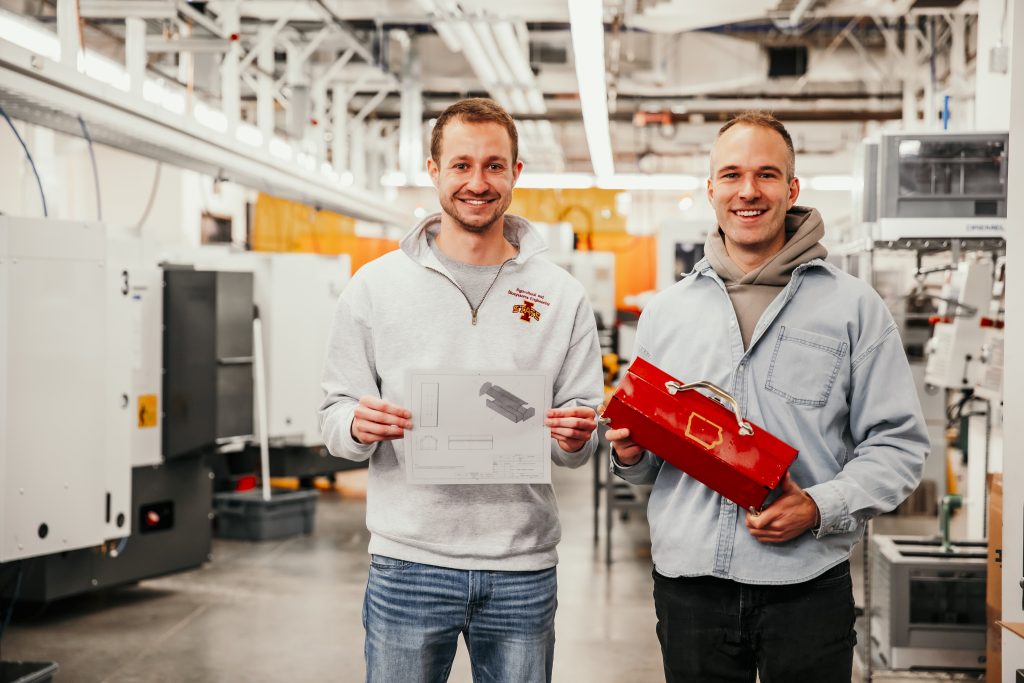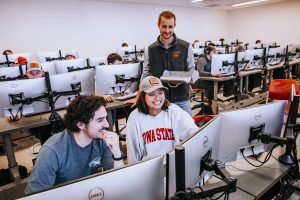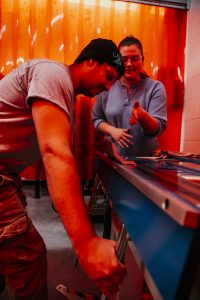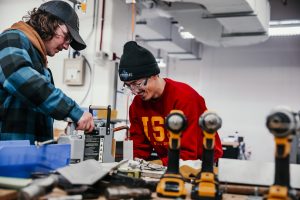
From design theory to hands-on manufacturing, students in the Department of Agricultural and Biosystems Engineering (ABE) are experiencing the entire design and development process through the teamwork of two new faculty members in ABE.
Chad Dolphin and Bailey Adams are faculty members that were brought on board to ABE just this year. While the classes they teach are each in different concepts (systems modeling and manufacturing), the two came up with an idea to merge together their courses so students can experience the manufacturing process from beginning to end. In Adams’ class, TSM 216, students learn how to make technical drawings representing products for manufacturing. In Dolphin’s class, TSM 240, students practice the hands-on challenge of manufacturing a high-quality product.

By merging the classes, students are learning how to translate their ideas from prints and 3D models and present them to someone out on the assembly floor. For one of the key merged assignments this semester, students are bringing their own version of a sheet metal toolbox to life.

“This semester, we have been working together to better merge and create more synergy between TSM 216 and TSM 240,” Adams said. “We wanted to allow students a better opportunity to experience the full design process through practical, hands-on application. “By merging our classes, students are able to create prints of a variety of parts and assemblies in TSM 216 and then physically take those prints with them to TSM 240 to manufacture these products and better understand the whole design process throughout.”
In Adams’ class, students are designing the parts and prints of the sheet metal toolbox using CAD software in the lab.
“In this course, students are learning about the science and principles behind sheet metal design and how to properly design sheet metal parts in the CAD software first,” Adams said.
After the students create the prints of the overall toolbox, they bring their prints to Dolphin in TSM 240, Introduction to Manufacturing, with an emphasis on metals. At the start of TSM 240, students physically draw out the instructions from their print onto the sheet metal and begin executing the manufacturing process. In the manufacturing process, students bend metal in the lab to match the angles they calculated in Adams’ class to shape the steel into the skeleton of a toolbox. Once they create the outline of the toolbox, they use techniques such as spot welding to keep everything in place.
“Technical drawings serve as the roadmap to take an idea from an engineers’ mind to a tangible product; very few classes offer students experience working through both the ideation process, and fabrication process,” Dolphin said. “By working together, we are showing cohesiveness, and showing them real world examples on how these process are carried out in the industry setting.”

Learning the ins and outs of the systems modeling and manufacturing processes and putting them together is a valuable skill to bring to future careers, the two faculty members said.
“To be a good designer and understand that parts are never as perfect as their representation in the CAD models, you have to see the whole design process throughout and truly experience the realistic elements of physical manufacturing processes,” Adams said. “Merging our classes adds value by increasing their fundamental understanding of design principles.”
“In the past, these classes really haven’t coincided with each other, so we wanted to tie them together and show a direct relation to the students so that they are seeing a project that they work on in one class be physically created in the next class,” Dolphin said.
Once the toolboxes are done, the students are able to keep their toolboxes for their own projects and goals – a lesson of teamwork and theory execution that will last for years to come.
